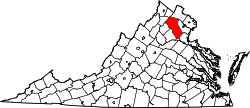Remington, Virginia
| Remington, Virginia | |
|---|---|
| Town | |
|
Central Remington | |
|
Location of Remington, Virginia | |
| Coordinates: 38°32′8″N 77°48′29″W / 38.53556°N 77.80806°WCoordinates: 38°32′8″N 77°48′29″W / 38.53556°N 77.80806°W | |
| Country | United States |
| State | Virginia |
| County | Fauquier |
| Area | |
| • Total | 0.2 sq mi (0.6 km2) |
| • Land | 0.2 sq mi (0.6 km2) |
| • Water | 0.0 sq mi (0.0 km2) |
| Elevation | 272 ft (83 m) |
| Population (2008) | |
| • Total | 598 |
| • Density | 2,876.4/sq mi (1,110.6/km2) |
| Time zone | Eastern (EST) (UTC-5) |
| • Summer (DST) | EDT (UTC-4) |
| ZIP code | 22734 |
| Area code(s) | 540 |
| FIPS code | 51-66512[1] |
| GNIS feature ID | 1499948[2] |
Remington is a small incorporated town in Fauquier County, Virginia, United States. The population was 598 at the 2010 census. It is near the highways, U.S. Route 15, U.S. Route 17, U.S. Route 29, and Virginia State Route 28. Remington is less than a mile northeast of the Culpeper County line.
History
The town of Remington developed as a transportation hub. It was a commercial port during the mid-nineteenth century on the Rappahannock Canal, but the canal failed financially and operations were abandoned. Later, the town was a stop on the Orange and Alexandria Railroad called Rappahannock Station, but the O&A was eventually absorbed into the Norfolk Southern system, and the Remington spur fell into disuse.
Remington was the site of the First Battle of Rappahannock Station and the Second Battle of Rappahannock Station during the American Civil War. Colonel John S. Mosby made raids in the town during the war, and, later, he made his home and practiced law in nearby Warrenton, Virginia.
The Remington Historic District was listed on the National Register of Historic Places in 2005.[3]
Geography
Remington is located at 38°32′8″N 77°48′29″W / 38.53556°N 77.80806°W (38.535464, -77.808117).[4]
According to the United States Census Bureau, the town has a total area of 0.2 square miles (0.6 km²), all of it land.
Demographics
| Historical population | |||
|---|---|---|---|
| Census | Pop. | %± | |
| 1900 | 198 | — | |
| 1910 | 251 | 26.8% | |
| 1920 | 267 | 6.4% | |
| 1930 | 273 | 2.2% | |
| 1940 | 226 | −17.2% | |
| 1950 | 309 | 36.7% | |
| 1960 | 288 | −6.8% | |
| 1970 | 321 | 11.5% | |
| 1980 | 425 | 32.4% | |
| 1990 | 460 | 8.2% | |
| 2000 | 624 | 35.7% | |
| 2010 | 598 | −4.2% | |
| Est. 2015 | 627 | [5] | 4.8% |
As of the census[1] of 2010, there were 598 people, 238 households, and 163 families residing in the town. The population density was 2,876.4 people per square mile (1,095.1/km²). There were 255 housing units at an average density of 1,175.5 per square mile (447.5/km²). The racial makeup of the town was 74.41% White, 17.56% African American, 0.17% Native American, 0.67% Asian, 4.35% from other races, and 2.84% from two or more races. Hispanic or Latino of any race were 6.19% of the population.
There were 238 households out of which 36.1% had children under the age of 18 living with them, 41.6% were married couples living together, 19.3% had a female householder with no husband present, and 31.5% were non-families. 23.5% of all households were made up of individuals and 7.1% had someone living alone who was 65 years of age or older. The average household size was 2.60 and the average family size was 3.02.
In the town the population was spread out with 27.9% under the age of 18, 10.3% from 18 to 24, 34.6% from 25 to 44, 20.4% from 45 to 64, and 6.9% who were 65 years of age or older. The median age was 33 years. For every 100 females there were 85.2 males. For every 100 females age 18 and over, there were 87.5 males.
The median income for a household in the town was $36,765, and the median income for a family was $37,969. Males had a median income of $31,250 versus $20,750 for females. The per capita income for the town was $16,693. About 11.0% of families and 13.6% of the population were below the poverty line, including 21.0% of those under age 18 and 12.5% of those age 65 or over.
Notable people
References
- 1 2 "American FactFinder". United States Census Bureau. Retrieved 2008-01-31.
- ↑ "US Board on Geographic Names". United States Geological Survey. 2007-10-25. Retrieved 2008-01-31.
- ↑ National Park Service (2010-07-09). "National Register Information System". National Register of Historic Places. National Park Service.
- ↑ "US Gazetteer files: 2010, 2000, and 1990". United States Census Bureau. 2011-02-12. Retrieved 2011-04-23.
- ↑ "Annual Estimates of the Resident Population for Incorporated Places: April 1, 2010 to July 1, 2015". Retrieved July 2, 2016.
- ↑ "Census of Population and Housing". Census.gov. Retrieved June 4, 2015.
External links
- Official Website - Town of Remington, Virginia
- Remington Police Department
- Remington Volunteer Fire & Rescue Dept
.jpg)
